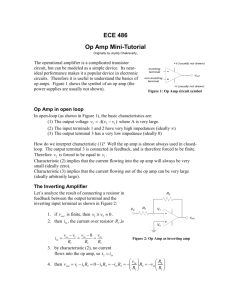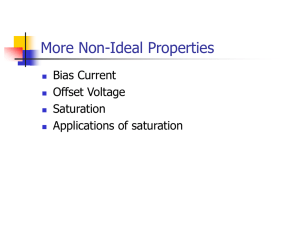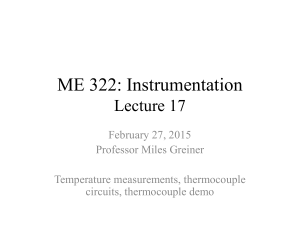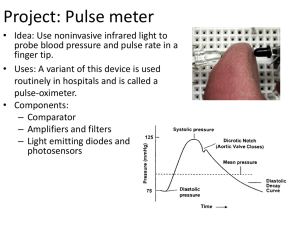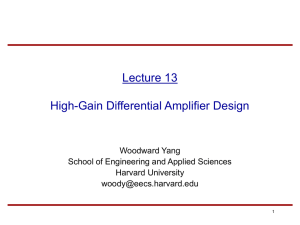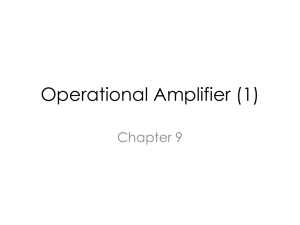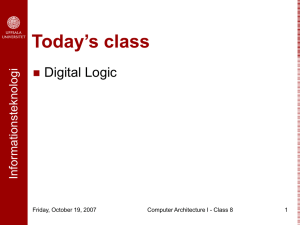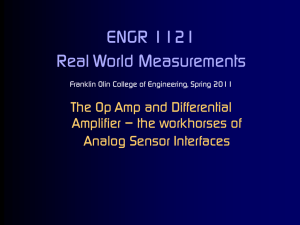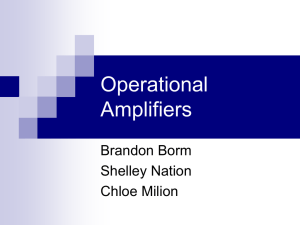Op Amps II
advertisement
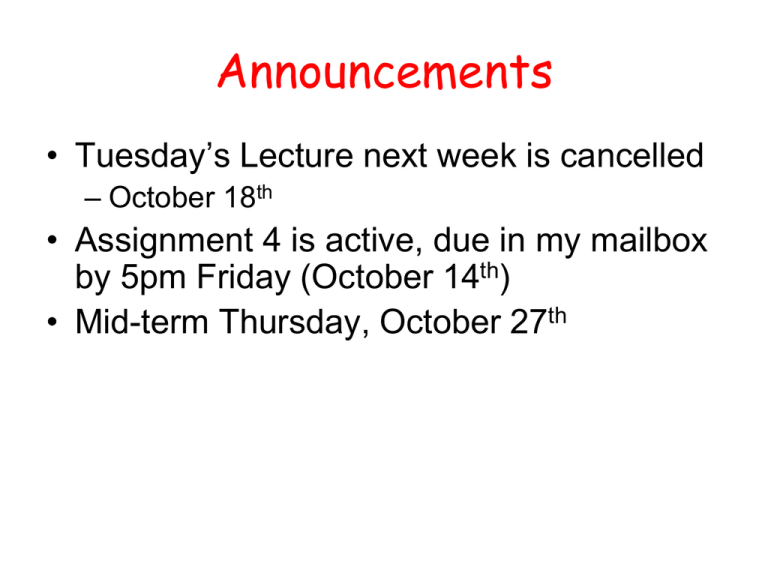
Announcements • Tuesday’s Lecture next week is cancelled – October 18th • Assignment 4 is active, due in my mailbox by 5pm Friday (October 14th) • Mid-term Thursday, October 27th Project Dates • Project Description - one paragraph, plus circuit diagrams and web links – email to me by Tuesday Nov 1st • Guidelines and a few useful links are here: http://www.physics.udel.edu/~jholder/Phys645/Lab/Projects.ht m . There are many more sites if you search the web (e.g. google “hobby electronics”) • Kits are allowed, but circuits must be assembled on the prototyping board. $50 maximum budget. • Once approved, I will need a complete parts list, with digikey or radioshack catalog part numbers. I will place the orders, but FINDING THE CORRECT COMPONENTS AND GETTING THEM IN TIME IS YOUR RESPONSIBILITY!!! Note that most basic components (resistors, capacitors etc.) are available in the lab. • The project should (ideally) contain both analog and digital • You should work with your lab partner, but individual reports are required for the projects. • The project counts for 20% of your final grade (I grade them) • I will leave copies of some good past projects in the lab (please don’t take them away) Lecture 12 Overview • Op amp circuits – amplifiers – Adding/ Subtracting – Integrating Circuit – Differentiating Circuit – Active Filters Recap: Opamps • DC coupled, very high gain, differential amplifier. • Feed part of the output back into the inverting input to get stable operation in the linear amplification region • Golden rules under negative feedback: • The voltage at the inputs is the same (v+=v-) • No current flows into the opamp (i+=i-=0) Op amp circuit 2: Inverting Amplifier • Signal and feedback resistor, connected to inverting (-) input. • v+=v- connected to ground iS iF iin 0 iS iF vout v vS v v+ grounded, so: RF RS v v 0 v 0 vS 0 out RF RS vout RF vS RS Gain vout R F vS RS Op amp circuit 3: Summing Amplifier • Same as previous, but add more voltage sources i1 i2 ..... iN iF vS 1 vS 2 vSN vout ..... RS1 RS 2 RSN RF vout RF RF RF vS 1 vS 2 ..... vSN RS 2 RSN RS1 If RS1 RS 2 ... RSN RS vout RF (vS1 vS 2 ... vSN ) RS Summing Amplifier Applications • Adds signals from a number of waveforms • Applications - audio mixer • http://wiredworld.tripod.com/tronics/mixer.html • Can use unequal resistors to get a weighted sum • For example - could make a 4 bit binary - decimal converter • 4 inputs, each of which is +1V or zero • Using input resistors of 10k (ones), 5k (twos), 2.5k (fours) and 1.25k (eights) Op amp circuit 4: A non-inverting amplifier • Feedback resistor still to inverting input, but no voltage source on inverting input (note change of current flow) • Input voltage to non-inverting input iS iF v v since iin = 0 v 0 vout v RS RF and v - = v + = v S (since no current flows through R) vout vout RF 1 RS RF 1 RS v vS vout RF Gain 1 vS RS Op amp circuit 5: Differential Amplifier (subtractor) i1 i2 0 vout v v1 v R1 R2 v v v R2 v2 v R1 R2 vout R2 (v2 v1 ) R1 Useful terms: • if both inputs change together, this is a common-mode input change • if they change independently, this is a normal-mode change • A good differential amp has a high common-mode rejection ratio (CMMR) Differential Amplifier applications • Very useful if you have two inputs corrupted with the same noise • Subtract one from the other to remove noise, remainder is signal • Many Applications : e.g. an electrocardiagram measures the potential difference between two points on the body http://www.picotech.com/applications/ecg.html The AD624AD is an instrumentation amplifier - this is a high gain, dc coupled differential amplifier with a high input impedance and high CMRR (the chip actually contains a few opamps) Op-amp integrator Op-amp integrator iF = -iS CF d(v out - 0) v =- S dt RS 1 v out (t) = RS CF t òv -¥ S (t)dt Integrator Application: Ramp Generator V Integrator response to a constant voltage: VIN This is a ramp generator - very useful in timing circuits... t VOUT V • What's the integrator response to a square wave? Integrator Application: Ramp Generator V Integrator response to a constant voltage: VIN This is a ramp generator - very useful in timing circuits... t VOUT V • What's the integrator response to a square wave? VIN t • ...Useful for waveform generators: VOUT What does this do? Op-amp differentiator iF iS vout dvS CS RF dt dvS vout (t ) RF CS dt Differentiator • Differentiator response to a square wave?: Differentiator Application: edge detection VIN • Differentiator response to a square wave?: • The differentiator is good at detecting edges, or transitions - very useful in digital circuits. t VOUT N.B. Don't confuse the differentiator with a differential amplifier (subtractor)! Other "mathematical operator" circuits can be easily constructed: • • • • • Logarithm Antilogarithm Multiplier Divider Square root function What about complex impedances? Vout Z F VS ZS Vout ZF 1 VS ZS Active low-pass filter A( j ) Vout Z F VS ZS 1 1 1 1 Z F RF j C F ZF RF 1 j RF C F A( j ) Max Amplification: RF/RS Low pass factor: 1/(1+ jωRFCF) Cut-off frequency (-3dB = 1/√2) when ωRFCF=1, ie ω0=1/RFCF RF / RS 1 j RF C F e.g. RF/RS=10; 1/RFCF=1 Active high-pass filter A( j ) Vout Z F VS ZS 1 Z S RS jC S RF A( j ) RS RF RS 1 Max Amplification: RF/RS High pass factor: 1/(1+ 1/jωRSCS) Cut-off frequency: ωRFCF=1 1 jC S 1 1 jRS C S e.g. RF/RS=10; 1/RFCF=1 Active band-pass filter Combine the two: jRF CS A( j ) (1 jRF CF )(1 jRS CS ) Advantages of active filters: 1)no inductors (large, pick-up) 2)buffered (high input impedance, low output impedance) – so filter performance independent of source and load; can cascade filters

